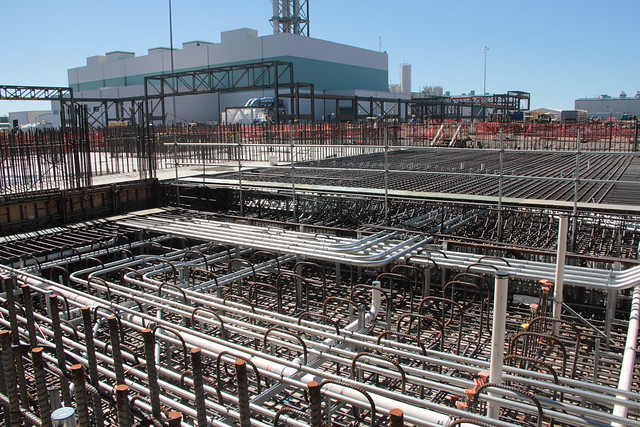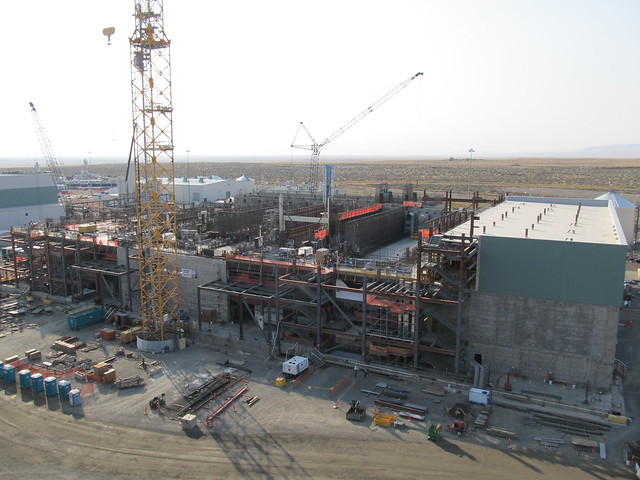The highly radioactive dregs of WWII and cold war bomb-making continue to evolve explosive hydrogen gas, corrode and leak through tanks, while plans to clean them up continue to fail. 53 million gallons of high-level defense waste are held in 177 underground tanks, 149 of which are single-shelled and leak-prone. One million gallons of radioactive waste, leaked into groundwater, is seeping towards the Columbia river. The Bush-Cheney administration fast-tracked a risky, untested, plan to simultaneously design and build a waste processing and vitrification facility to dispose of the highly radioactive residue of plutonium production. Costs have already run 3 times over the original $4.3 billion budget and the promised completion date in 2011 has been put off indefinitely. The basic design of the waste processing system called the "pretreatment facility" may be critically flawed. The GAO has written multiple reports finding multiple faults with the safety, design, construction, and management of the Waste Treatment Plant (WTP) project. Multiple whistleblowers have exposed severe safety, design and management problems with the project.
One of the project's managing engineers, Walter Tamosaitis, Ph.D., the Manager of Research and Technology found that design problems that could lead to hydrogen explosions within the "pretreatment facility" had not been met by Bechtel, the prime contractor, before it claimed a $6 million timely performance payment. He discussed his safety concerns with Bechtel managers, presenting them with a 50 item problem list on July, 1, 2010. On July 2, 2010 he was escorted from his office, demoted, then sent to an offsite basement office with no furniture and no work assignment. The Seattle Weekly obtained e-mail evidence that Frank Russo, who Bechtel named Director of WTP in January 2010, orchestrated the crack down on Tamosaitis.
In an e-mail dated March 31, 2010, Russo updated President Obama appointee Inés Triay on the situation. Triay, who did not return calls seeking comment, served as Assistant Secretary for Environmental Management and oversaw the DOE’s Hanford work until July, at which time she stepped down.The waste processing facility, known as the "pretreatment facility", where the tank wastes are chemically processed and separated into high-level and low-level wastes, in preparation for vitrification and disposal, is the focus of safety concerns about WTP. In the mid-90s, a British design firm chose a "black box" closed cell design, used for nuclear reprocessing in the UK over open "trench" designs which had been used in U.S. reprocessing. The closed cell design was attractive because it had the potential of reducing radiation exposure to workers, but it is virtually impossible to repair if anything goes wrong. Scaling up the closed cell design to the volume, complexity and explosiveness of the waste at Hanford has, to date, been an intractable problem. Because the tank waste is not fully characterized, we don't know what's in some of the tanks, the design safety of the closed cells has been contentious.“It was like herding cats,” Russo wrote Triay about a meeting he’d had with senior contract scientists and engineers regarding his quest to stay on schedule. “Scientists . . . were in lock step harmony when we told them the science is ending. They all hated it . . . I will send anyone on my team home if they demonstrate an unwillingness or inability to fulfill my direction.”
“Walt is killing us,” Russo later e-mailed Bill Gay of URS on July 1, 2010, who though removed from the chain of command still had to sign off on Tamosaitis’ removal.
“Get him in your corporate office today.”
“He will be gone tomorrow,” Gay replied.

Alexander knows his nuclear disasters well, as he led one of the DOE’s first scientific delegations to Russia’s Mayak nuclear facility in 1990. Mayak, one of the largest nuclear production plants in the former Soviet Union, suffered a deadly accident in 1957 when a tank containing nuclear materials exploded. The Mayak facilities are comparable to the plutonium production units built at Hanford, which is considered a “sister facility.” Since they are so close in design and makeup, Mayak is often seen as an example of what can go wrong with the production of plutonium and the storage of nuclear waste at Hanford. Alexander’s team negotiated the transfer of data collected by the Soviets on the health effects of Mayak’s radioactive release, establishing a program that allows Russian and U.S. scientists to share nuclear cleanup technologies and research.He has applied the lessons learned from that disaster to his oversight of WTP safety. In February, 2012 he filed a differing professional opinion concluding that the stainless steel pipes and radioactive waste processing cells were not durable enough to contain the highly abrasive and corrosive radioactive wastes for the 40 year planned plant lifetime. Some of the solids that settled to the bottom of the waste tanks are very hard, abrasive, insoluble oxides. These hard solids would abrade the relatively soft stainless steel used in the waste processing facility. He determined the pretreatment facility would likely fail because of abrasion many years into its 40 year lifetime when it would be highly radioactive and impossible to repair.
An expert panel agreed with him and the other whistleblowers.
A treatment plant that the Energy Department is counting on to stabilize the radioactive waste at the nation’s largest environmental cleanup project, at the Hanford Nuclear Reservation in Washington State, has design problems that could lead to chemical explosions, inadvertent nuclear reactions and mechanical breakdowns, a federal advisory panel warned on Tuesday.

The nuclear safety board warned about the risk of explosion to Wyden, who wanted comment on the safety and operation of Hanford's tanks, technical issues that have been raised about the design of a plant to treat the waste in those tanks, and Hanford's overall safety culture.The prime contractor, Bechtel, wrote that they have addressed the hydrogen gas problem in the double walled tanks by installing and running active ventilation. However, the board has expressed continued concern that there is no back up if the active ventilation system loses power or breaks down.In addition to the leaks, the board noted concerns about the potential for hydrogen gas buildup within a tank, in particular those with a double wall, which contain deadly waste that was previously pumped out of the leaking single-shell tanks. "All the double-shell tanks contain waste that continuously generates some flammable gas," the board said. "This gas will eventually reach flammable conditions if adequate ventilation is not provided."
The board's concerns about the WTP are even more serious. The experts are concerned the plans won't work at all.
The board described the difficulties in a letter to Senator Ron Wyden, the Oregon Democrat who is the chairman of the Senate Energy Committee. Mr. Wyden said in an interview on Tuesday that the board’s experts had raised “a serious question as to whether this plant is going to work at all.”

In August 2012, a senior DOE manager wrote in an internal DOE memo that Bechtel should be removed as prime contractor for unsafe designs, multiple factual errors and violating federal standards.
In August, Gary Brunson, then the Energy Department's engineering division director, sent a memo to higher-level officials that alleged 34 instances in which Bechtel had committed factual errors, pursued unsafe designs or provided equipment that did not meet federal standards. Brunson said those failures had led to delays and increased costs and that the Energy Department should remove Bechtel as the design authority for the plant.However, Bechtel and it's subcontractors are continuing to suppress safety concerns according to a lawsuit filed this February by another manager turned whistleblower.After the Brunson memo, an investigation by the Energy Department's office of nuclear safety found in November that Bechtel had committed potential health and safety violations, a finding that could lead to a multimillion-dollar fine.
Donna Busche, the manager of environmental and nuclear safety for San Francisco-based URS Corp., alleged in a lawsuit filed Tuesday that executives at the $13.4-billion project attempted to suppress her warnings and were working to fire her. Busche, a nuclear engineer and health physicist, alleged that pressure to meet deadlines led the company to retaliate against her for insisting on stringent safety practices at the former nuclear weapons complex.Bechtel, the huge, politically powerful contractor has run roughshod over the tiny group DOE staff that are trying to manage the contract.
“One of the main problems at Hanford is that DOE is understaffed and overtasked,” Alexander explains. “As such, we cannot conduct in-depth reviews of each of the individual systems in the facilities. Therefore there is a high likelihood that several systems will be found to be inoperable or not perform to expectations.”Bechtel's management was enabled by DOE's political appointees to bully DOE's technical experts who were assigned to oversee the project. DOE's political appointees ceded project control to the contractor, Bechtel.
In an additional e-mail sent August 2, Alexander writes of how Bechtel management disregarded his early report that their design for the pulse jet mixers was flawed: “In the spring I raised a series of concerns with respect to the performance of the non-Newtonian vessels. Because I raised the issue, Frank Russo directed me to write my issues in a paper over the Easter weekend and deliver the paper on Monday April 5, 2010 . . . As a consequence the [Bechtel] manager labeled my issues as the ‘non- Newtonian curve-ball.’ Since when are DOE staff supposed to take direction from Contractor management? . . . Mr. Russo also directed Dr. Walter Tamosaitis to gather as many top flight PhDs as possible together to discredit my paper. I requested that my paper receive appropriate peer review but that request was denied. Walt had trouble even assembling a team. Walt knew that my issues were technically correct and he never submitted a counter paper.”The DOE's management structure, which places almost all of its technical expertise in the national laboratories, is incapable of competently and safely directing the WTP. Bechtel's management has gone directly to political appointees at DOE, eliminating all effective technical oversight. Bechtel should be fired for violating federal rules, regulations and standards, but that should be only the first step. The President and congress need to establish an effective management structure within DOE or a new separate organization to safely-control the management and disposal of defense and civilian nuclear wastes.
The expert review board's devastating report follows a scathing December, 2012 report by the GAO. Details follow.
